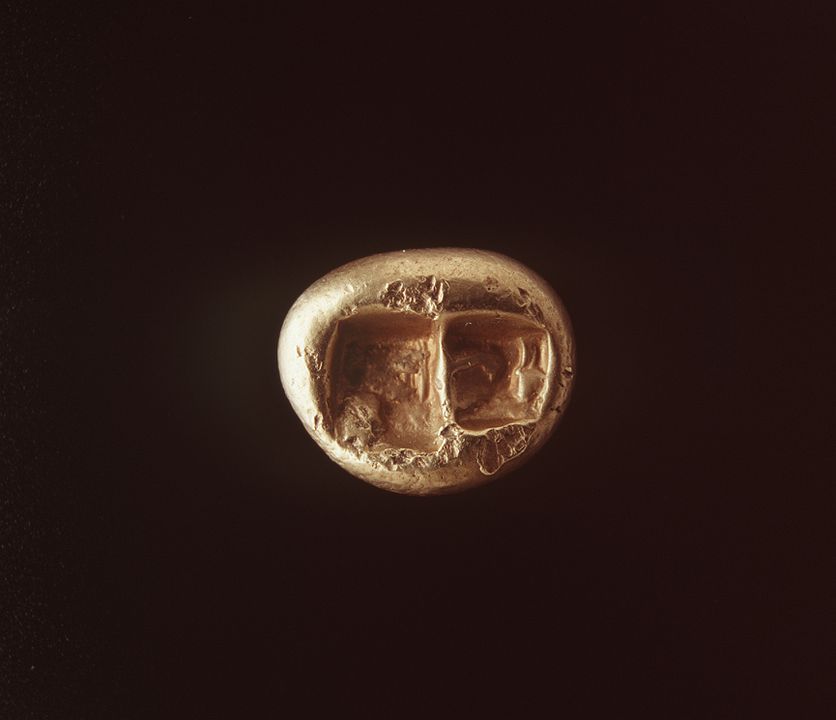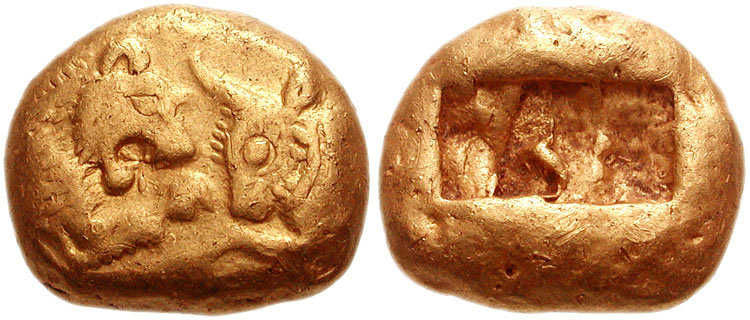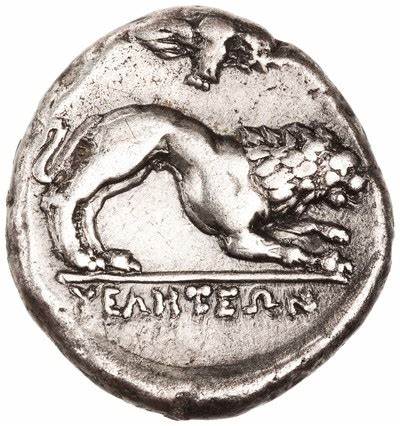

-660
World's Oldest True Coin
The world's first modern coin, with heritage that can be traced through time to coins in use today.
Today’s article is about one of the longest-standing and most recognisable incarnations of money today, the humble coin. But first, what even is a coin? The Encyclopaedia Britannica describes a coin as a “piece of metal or, rarely, some other material (such as leather or porcelain), certified by a mark or marks upon it as being of a specific intrinsic or exchange value”. We would add that the value that is held by the coin, is, in almost all cases, issued by a government, king or whoever might be at the head of the society. This is because, of course, the coins need to be manufactured, in huge quantities and given a value to which all of society must either agree, or have forced, upon them – and few institutions other than government have those capabilities. They are also small enough to be held in your hand, with multiple coins easily carried in a pocket, pouch, purse or wallet. They are also usually, but not always, circular in shape and relatively thin in proportion to their diameter.
As it turns out, coins go back a long way. Infact the oldest known coins are over 2,500 years old. Recently, archaeologists in China have discovered what could be the world’s oldest ever coin factory and after carbon-dating of some coin fragments found there, dated them to around 640-550AD. However, the oldest coin with potentially direct lineage to the government-issued money that is still use today - while sticking to the rules we applied in the section above on what constitutes a coin - is very likely to be the Lydia ‘Lion’ Stater. This coin has been dated at least as far back 630AD, with some sources saying they could possibly be even up to a century older.
Although the earliest mint that has been dated in Lydia is only 575-550AD, coins that are older than that were made somewhere in Lydia and the Stater’s provenance puts it right in the spotlight for the crown of the world’s oldest proper coin. There were many other types of coin before the Lydia Staters, including the suspected coins produced in the mint found in Ancient China; these were generally pieces of metal with cut marks or scrapes, possibly to dictate their value by numeracy, but they lacked the certain characteristics that we use to define a coin today – such as the government-issued mark and a society-wide standardised value – and no other coin had as wide reach as the Lydian Stater.
The stater was made by taking a small piece of the naturally forming electrum metal-alloy and placing it on a die, which in turn was placed upon an anvil. The piece was then struck with a hammer and punch, to force the metal into the relief of the die and forge the coin. The designs on the Lion Stater’s themselves ranged from stylised lion heads to complete lions, occasionally with additional markings. Most coins had the design on one side and an imprint of the design on the reverse, created by punching the metal into the die, however some coins had artwork and marks on both sides.

The Stater weighed about 14g, and estimates put the Stater at around a month’s salary for the average worker at that time, so as you might expect, there are smaller denominations of the Stater, from thirds to sixths, twelfths, twenty-fourths and almost definitely smaller fractions still, allowing for the smaller transactions and purchases to be carried out on a day-to-day basis. It’s interesting to think how getting paid each month by a single coin, might affect your perception of it.
The exquisite detail found on the lions is a tribute to the artistic skills of the Lydian sculptors of their day. Holding one of these shiny metal pieces of art, glinting in the Mediterranean sunshine, must have given the bearer a real pleasure and compared to the usual bartering of basic marked stones and metal shard, this would of been the equivalent of putting a piece of royal jewellery in the hand of the everyone.
It is quite remarkable when you think about it, there are very few things still in use today that were invented over 2,000 years ago, nevermind one that is so fundamental to our society. Yet, essentially, in their basic form, coins haven’t really changed much at all. The point in time where we mark the oldest, modern-style coin, around 600AD, is just that – the same type of coin that we still find is use today - a government-issued piece of metal, with a mark showing the user it’s transgressive value.
Some scholars believe that the Lydians even invented the free market too and we can see why they might think that. The Lydian’s were situated on the western coast of modern-day Turkey, at the same time as the Ancient Greeks. The creation of the Stater coincided with the Greeks’ themselves becoming one of the wealthiest cultures of all time, but this did not last more than a couple of centuries, as soon after their prosperity hit its peak came the end of antiquity. Could the rise and fall of the end of the Ancient Greeks classical era be in any way attributed to the created of the first ever true coin? We can only speculate, but the Lydian’s were close friends with their Greek neighbours, avid traders and at the very least they most certainly played a prominent part in spreading the concept of a government-issued coin, at least in the majority of the world - and Lydian inspired free-trade and prosperity - around the world. The Lydian’s were a key link between the Middle Eastern and the Far East, bringing huge volumes of goods and trade through their ports and there is no doubt that their creation of a beautiful, white-gold, standardised coin, played a large part in their accumulation of great wealth and the explosive increase in currency and world trade ever since.

Other cities and societies soon started producing their own coins in the centuries that followed, also by stamping their emblems on similar-sized pieces of electrum. The Romans, Persians, Ottoman, Chinese and many more empires can all trace their coins back to to the original Stater. Despite all that has happened in the last couple millennia, with empire’s rising and falling along the way, the coin - and possibly even the free market - can all be traced back to around 2,600 years ago, as one of the greatest cultures of all time was coming to an end, just across the Aegean Sea, another culture with an economic legacy of its own, was being born.
Today’s coins are usually, but not always, made from metals that are far cheaper to produce than the value that they hold in our minds. The artwork may have gained a bit more intricacy to deter forgery, but despite that they no longer hold the same intrinsic worth as they once did - there are still estimated to be billions of discarded and lost coins around the world, with the metal used being worth relatively little in comparison with the value they hold diminishing over time this is only set to increase. National mints, which are today independent of governments, working alongside them, are constantly producing new coins to keep their circulation going, but the financial cost of producing them is already outweighing the benefit of having them.

As inflation in a society rises, as does the need for coin’s values in proportion to people’s wages, but as costs to produce them increases and the world of money gets ever more digital, the desire to produce and circulate coins has naturally become less and less of a priority over recent years, infact many governments, central banks, banking institutions and economists are giving strong hints that the end of the coin is near.
There are businesses out there which are trying to plug this gap and bring the multi-millennia old, metal-token of superficial value into the digital age, but even with their help, we predict that coins will only become more and more rare and wonder if coins might exist at all in another 25 years, let alone another 2,500+ years. While we started this article by pondering where the first coin came from, we are left with the feeling, despite standing the test of time for over two millennia, that coins might finally have reached their own age of antiquity and the Lydian Lion might be roaring its final roars.
https://www.britannica.com/topic/coin
https://www.nationalgeographic.co.uk/history-and-civilisation/2021/08/worlds-oldest-coin-factory-discovered-in-china
http://rg.ancients.info/lion/article.html
https://fleur-de-coin.com/articles/oldest-coin

